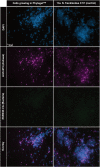Cultivation of ammonia-oxidising archaea on solid medium
- PMID: 35323924
- PMCID: PMC9072212
- DOI: 10.1093/femsle/fnac029
Cultivation of ammonia-oxidising archaea on solid medium
Abstract
Ammonia-oxidising archaea (AOA) are environmentally important microorganisms involved in the biogeochemical cycling of nitrogen. Routine cultivation of AOA is exclusively performed in liquid cultures and reports on their growth on solid medium are scarce. The ability to grow AOA on solid medium would be beneficial for not only the purification of enrichment cultures but also for developing genetic tools. The aim of this study was to develop a reliable method for growing individual colonies from AOA cultures on solid medium. Three phylogenetically distinct AOA strains were tested: 'Candidatus Nitrosocosmicus franklandus C13', Nitrososphaera viennensis EN76 and 'Candidatus Nitrosotalea sinensis Nd2'. Of the gelling agents tested, agar and Bacto-agar severely inhibited growth of all three strains. In contrast, both 'Ca. N. franklandus C13' and N. viennensis EN76 tolerated Phytagel™ while the acidophilic 'Ca. N. sinensis Nd2' was completely inhibited. Based on these observations, we developed a Liquid-Solid (LS) method that involves immobilising cells in Phytagel™ and overlaying with liquid medium. This approach resulted in the development of visible distinct colonies from 'Ca. N. franklandus C13' and N. viennensis EN76 cultures and lays the groundwork for the genetic manipulation of this group of microorganisms.
Keywords: Phytagel; ammonia-oxidising archaea; colonies; cultivation; solid medium; solidifying agent.
© The Author(s) 2022. Published by Oxford University Press on behalf of FEMS.
Figures





Similar articles
-
Distinct Patterns of Antibiotic Sensitivities in Ammonia-Oxidising Archaea.Environ Microbiol. 2025 Mar;27(3):e70063. doi: 10.1111/1462-2920.70063. Environ Microbiol. 2025. PMID: 40070055 Free PMC article.
-
Isolation of 'Candidatus Nitrosocosmicus franklandus', a novel ureolytic soil archaeal ammonia oxidiser with tolerance to high ammonia concentration.FEMS Microbiol Ecol. 2016 May;92(5):fiw057. doi: 10.1093/femsec/fiw057. Epub 2016 Mar 13. FEMS Microbiol Ecol. 2016. PMID: 26976843 Free PMC article.
-
Characterisation of terrestrial acidophilic archaeal ammonia oxidisers and their inhibition and stimulation by organic compounds.FEMS Microbiol Ecol. 2014 Sep;89(3):542-52. doi: 10.1111/1574-6941.12353. Epub 2014 Jul 31. FEMS Microbiol Ecol. 2014. PMID: 24909965 Free PMC article.
-
Ammonia-oxidising archaea--physiology, ecology and evolution.Adv Microb Physiol. 2010;57:1-41. doi: 10.1016/B978-0-12-381045-8.00001-1. Adv Microb Physiol. 2010. PMID: 21078440 Review.
-
Diversity, physiology, and niche differentiation of ammonia-oxidizing archaea.Appl Environ Microbiol. 2012 Nov;78(21):7501-10. doi: 10.1128/AEM.01960-12. Epub 2012 Aug 24. Appl Environ Microbiol. 2012. PMID: 22923400 Free PMC article. Review.
Cited by
-
Activity-based labelling of ammonia- and alkane-oxidizing microorganisms including ammonia-oxidizing archaea.ISME Commun. 2024 Jul 11;4(1):ycae092. doi: 10.1093/ismeco/ycae092. eCollection 2024 Jan. ISME Commun. 2024. PMID: 39071849 Free PMC article.
-
Isolation and cultivation of a novel freshwater magnetotactic coccus FCR-1 containing unchained magnetosomes.Commun Biol. 2025 Mar 27;8(1):505. doi: 10.1038/s42003-025-07981-5. Commun Biol. 2025. PMID: 40148482 Free PMC article.
-
Distinct Patterns of Antibiotic Sensitivities in Ammonia-Oxidising Archaea.Environ Microbiol. 2025 Mar;27(3):e70063. doi: 10.1111/1462-2920.70063. Environ Microbiol. 2025. PMID: 40070055 Free PMC article.
-
Shedding light on the composition of extreme microbial dark matter: alternative approaches for culturing extremophiles.Front Microbiol. 2023 Jun 2;14:1167718. doi: 10.3389/fmicb.2023.1167718. eCollection 2023. Front Microbiol. 2023. PMID: 37333658 Free PMC article. Review.
-
A Simple and Effective Method for Solid Medium Cultivation of Strictly Hydrogen- and Sulfur-oxidizing Chemolithoautotrophs Predominant in Deep-sea Hydrothermal Fields.Microbes Environ. 2023;38(6):ME23072. doi: 10.1264/jsme2.ME23072. Microbes Environ. 2023. PMID: 38104970 Free PMC article.
References
-
- Altschul SF, Gish W, Miller Wet al. . Basic local alignment search tool. J Mol Biol. 1990;215:403–10. - PubMed
-
- Beeckman F, Motte H, Beeckman T. Nitrification in agricultural soils: impact, actors and mitigation. Curr Opin Biotechnol. 2018;50:166–73. - PubMed
-
- Brochier-Armanet C, Boussau B, Gribaldo Set al. . Mesophilic Crenarchaeota: proposal for a third archaeal phylum, the Thaumarchaeota. Nat Rev Microbiol. 2008;6:245–52. - PubMed

